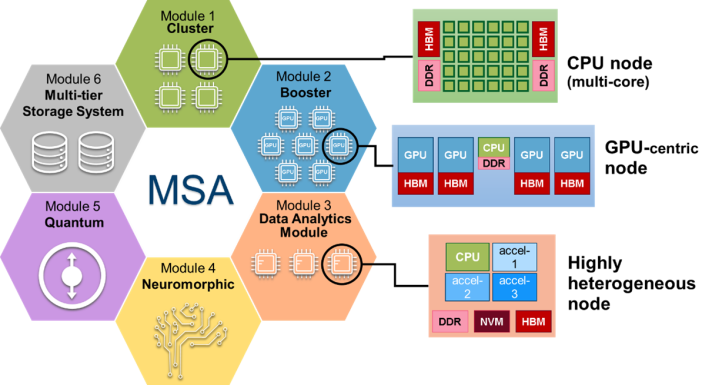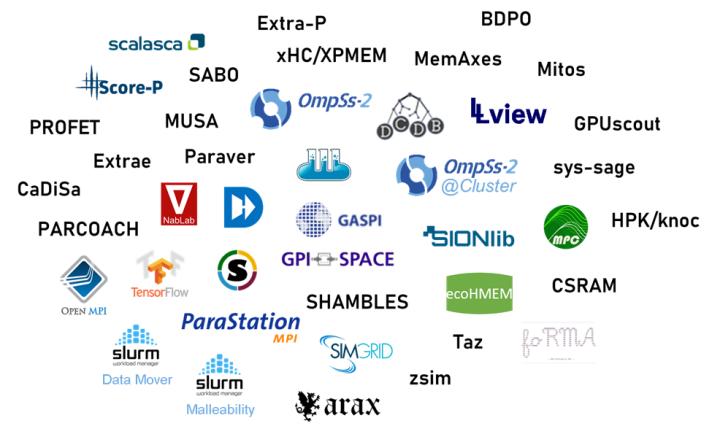
DEEP-SEA was launched in April 2021 and is part of the DEEP project series, a series of research projects supported and funded by the European Union. DEEP stands for Dynamical Exascale Entry Platform. Since 2011, the DEEP series of projects (DEEP, DEEP-ER, DEEP-EST) have pioneered an innovative concept known as the Modular Supercomputer Architecture (MSA), a design for heterogeneous HPC systems that focusses on efficiency and scalability. This concept is now paving the way for the upcoming HPC milestone: exascale computing.
The project, which lasted for 36 months, concluded on 31 March 2024, and had a total budget of 15,069,476.25 EUR. Half of this budget was provided by Horizon Europe, while the remaining half was funded by a consortium comprising member states of the European Union: Belgium, Germany, France, Greece, Spain, Sweden and Switzerland.
The EuroHPC JU interviewed Estela Suarez, a Professor at the University of Bonn in the department of computer science, and the group leader within the JSC’s division Technology, where she researches innovative system architectures for HPC. Professor Suarez has also been recently elected Chair of the EuroHPC Joint Undertaking Advisory Group RIAG. Below, she answered our questions on the DEEP-SEA project, that she coordinated throughout its three years duration.
Can you please describe the DEEP-SEA project, its key objectives and what progress has been made?
The DEEP-SEA project developed and validated an integrated software stack for European Exascale systems. Our project was driven by a consortium comprising leading experts from both academia and industry within the HPC community.
The project aimed at improving the HPC system software, programming environments, and tools to effectively handle large and highly heterogeneous computing, networking and memory setups.
The DEEP-SEA software stack includes computation and communication libraries, resource management tools, and low-level kernel modules, which are small software packages that can be added to an operating system.
In addition, the project also conducted "Optimisation Cycles" (OCs), rounds of optimisation efforts to enhance systems and processes, and provided user-friendly advanced features to system operators, developers, and users. Finally, the software developed by DEEP-SEA has been released and it is publicly available to the HPC community through open software repositories.
Can you give some concrete examples of how your project supports European HPC users and how it promotes greener and more sustainable supercomputing?
Certainly! DEEP-SEA values European HPC users as well as sustainable supercomputing.
European HPC users today work on highly complex and heterogeneous systems, which can achieve tremendous performance and high energy efficiency.
Nevertheless, users often find this challenging due to the complexity of these systems. The aim of DEEP-SEA was to provide a software stack capable of handling hardware complexity, while providing tools to help users achieve high levels of performance and energy efficiency across existing and future architectures and systems.
In addition to this, DEEP-SEA has also accommodated compute, memory and network heterogeneity in the project. On the compute side, CPUs, GPUs and other accelerators are combined on systems with multiple compute partitions also called “Modular Supercomputers”. In this context, users are invited to select which partition or combination of partitions they wish to use for their application or workflow. DEEP-SEA provides performance analysis and modelling OCs and provides recommendations to the users on the best and most efficient combination of resources for a specific application. These enable the user to maximise application performance and efficiency, without necessitating detailed knowledge of the hardware capabilities.
In terms of sustainability, we have created a cycle that boosts the energy efficiency of each application run without needing to change to the code. DEEP-SEA has also provided monitoring tools that give feedback to users on the energy consumption of their jobs and motivate them to reduce the CO2 footprint of their application runs.
What were the main challenges you encountered during the project's development, if any?
Any innovative endeavour like DEEP-SEA faces different types of challenges, including technical and operational ones.
On the technical side there are tight dependencies between different software components and tools that needed to be closely monitored to insure interoperability and performance, without causing excessive delays.
On the operational side, the success of a collaborative project like ours very much depended on the capacity of the team to work together in a constructive manner, following a common objective.
We started our project in early 2021, in the middle of a global pandemic, which also made it very difficult for the team to meet in person and properly get to know each other. We relied strongly on videoconference meetings and our project ran for more than one year in purely remote mode. We had weekly or biweekly online interactions between the different parts of the project and organised seminars to present different software developments to each other. It was a big relief when we could organise face-to-face meetings again and people could finally meet.
How is the development of such a project supporting the ambition of the EuroHPC JU to make Europe a world-leader in supercomputing?
EuroHPC JU continues to extend its fleet of HPC systems that together constitute a unique supercomputing infrastructure. Hardware deployments often get the spotlight, but their true value lies in their effective operation and utilisation, facilitated by a comprehensive set of reliable software tools.
Projects like DEEP-SEA contribute to the continuous improvement of the HPC software stack, ensuring that this know-how is also growing and expanding in Europe. The project brings forward European software developments, keeping them competitive, and contributes through these advanced tools to maximise the scientific results that European HPC applications can obtain, while reducing their energy consumption.
What’s next for your project and results developed under this project?
The software components and tools developed or enhanced within DEEP-SEA have been made available through public repositories. These repositories offer installation instructions, ensuring seamless deployment on any forthcoming system. Additionally, the new features and enhancements have been up-streamed to the developer repositories, so that future versions of the software involved in the project will build on the improvements done in DEEP-SEA.
Also, our partners actively participate in significant standardisation bodies, such as the MPI Forum or the OpenMP standardisation committee, to which they have presented the project approach and achievements. As a result, DEEP-SEA is currently undergoing evaluation for inclusion in upcoming standard versions, which promises a lasting influence on the future landscape of the HPC software stack.
Details
- Publication date
- 24 July 2024
- Author
- European High-Performance Computing Joint Undertaking


